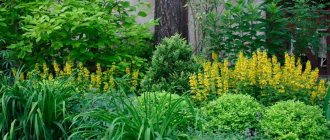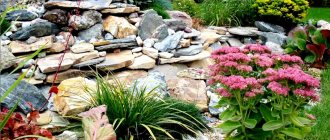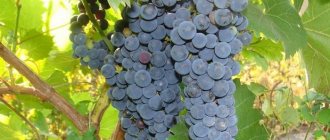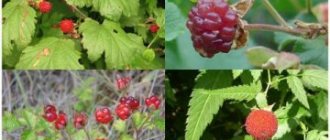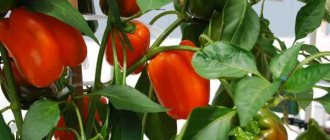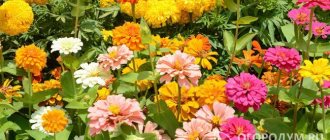Plants of the nightshade family belong to the dicotyledonous class and the flowering division. This family also has a separate order called Solanaceae, to which the Convolvulaceae family belongs. At the moment, the nightshade family has about 2,300 species. They are notable because most of the plants bear fruits that are widely used by humans. These include such famous crops as eggplants, tomatoes, peppers, potatoes and many others. Species include various herbs, shrubs and trees.
The majority of plants in the nightshade family grow wild. Most often, plants of this family grow in the territories of South and Central America in the form of herbs and shrubs, and woody species of this family are widespread in the tropics. In Russia you can find black nightshade, henbane and datura.
Types of nightshade plants
Acnistus
The most common perennial shrub of the Solanaceae family. It reaches a height of 4 meters, but can look like a small tree. The leaves of this plant are simple and with a length ranging from 5 to 10 centimeters. Acnistus flowers are tubular in shape and can be purple, white or blue. This flower is pollinated by hummingbirds and various insects, in particular bumblebees.
Belladonna
Belladonna is a perennial plant, which is represented by a multi-headed rhizome with a large number of branched roots. The stems of this plant are quite thick and densely pubescent. They are capable of reaching a height of two meters. The leaves are dark green and have a characteristic ovoid shape. The flowers are located in the axils of the leaves and have a brown-violet color. The fruiting period lasts from June to August.
Brugmansia
Brugmansia has a similar appearance to Datura. However, they have a number of significant differences. In Brugmansia, the flowers are arranged downward in a funnel, while in Datura they look up and to the sides. Brugmansia itself is a herbaceous, woody perennial with unusual large flowers that emit a pleasant aroma.
Calibrachoa
Calibrachoa is a herbaceous shrub that is often used for decorative purposes. This plant is distinguished by beautiful flowers with a diameter of no more than 3 centimeters. There are flowers of completely different colors and shades. In total there are about 18 varieties of pink, lilac, purple, red, cherry, yellow, crimson and orange.
Capsicum
Capsicus is an amazing plant that has become an indoor pepper. It was brought from tropical Mexico and Guatemala. Dwarf varieties of capsicus are used for decorative purposes. Flowers and fruits appear on branched stems. As a rule, the flowers are located alone, but can form bunches or pairs. They are capable of self-pollination, so the fruits grow indoors.
Cestrum
The cestrum plant has about 200 different species of shrubs or small trees. Among them there can be both deciduous and evergreen varieties. Cestrum leaves are dark green in color with a glossy surface. Tubular-shaped flowers look like rounded umbrellas. The flowers have a pleasant aroma that intensifies at night.
Datura
Datura has become a plant with a rather controversial reputation. It is distinguished by large and beautiful tubular flowers, but the plant itself is poisonous. Since ancient times, it has been cultivated by shamans to communicate with spirits. Now this flower is used to decorate landscapes, but with caution.
Beneficial properties and possible side effects
Nightshades have a number of beneficial properties and are low in calories. But if abused, they can be harmful, so do not make them the basis of your diet.
Tomatoes
Tomatoes serve as a source of nutrients:
- vitamins A and C;
- lycopenes;
- carotenoids.
Lycopenes contained in fruits help the body fight free radicals. They prevent the development of Alzheimer's disease, atherosclerosis, and hypertension. And research conducted by Dr. A. Bazu at the University of California, Davis Medical Center showed that including tomatoes in the menu reduces the risk of prostate cancer.
The product also reduces oxidative stress in tissues and slows down carcinogenesis - the process of tumor initiation and development. Experiments at the University of Pennsylvania showed that carotenoids are effective in preventing pancreatic cancer.
To benefit from the properties of tomatoes, eat 1 ripe medium-sized fruit per day.
If the product is abused, the risk of diseases increases:
- An abundance of tomatoes in the diet contributes to the formation of kidney stones. Urologist R. Sood, practicing in Delhi, associates the peculiarity with the presence of oxalic acid in the fruit.
- Tomatoes also provoke the development of heartburn: they contain malic and citric acid, which disrupt the pH balance of gastric juice. If you suffer from gastroesophageal reflux disease, eat less tomatoes.
Proponents of an alkaline diet also talk about the dangers of vegetables. According to its provisions, tomatoes and potatoes have the property of shifting the body’s pH towards acidification: you can read more about the phenomenon here.
Potato
Traditionally, potatoes are considered healthy, because the peel contains the following substances:
- vitamin B6;
- potassium;
- manganese.
But the valuable properties of the product are questionable, since peeled tubers do not contain an abundance of these substances.
Potatoes also contain a lot of carbohydrates, including starch, which is broken down into sugars in the body. For this reason, you should avoid it if you want to reduce body weight and prevent diseases associated with excess weight:
- hypertension;
- heart attacks;
- strokes;
- atherosclerosis.
The American Diabetes Association also recommends reducing potato consumption. According to her, the result will be normalization of blood sugar levels; the effect will be enhanced if you do not add other ingredients to the tubers.
Eggplant
Eggplants are a source of useful substances:
- dietary fiber;
- antioxidants.
Dietary fiber reduces the risk of cardiovascular disease and stimulates bowel function. The effectiveness has been proven by the work of Professor David Jenkins, conducted at the training center at St. Michael's Hospital in Toronto.
Antioxidants in eggplants have the ability to slow down premature skin aging from ultraviolet radiation, as proven by Dr. Radava R. Korak. They also prevent the appearance of age spots and reduce the risk of erythema after sun exposure.
But the beneficial effect is mainly due to the anthocyanins contained in the peel. If you cut it off when cooking, don't expect the eggplant to reduce oxidative stress in the body.
bell pepper
Bell peppers are rich in vitamin C, which promotes iron absorption. The benefits were proven by research by Dr. Prashant Thankachan conducted at the St. John's National Academy of Health in India. The scientist observed 2 groups of people suffering from iron deficiency and noted an improvement in the condition of those who received an increased dose of vitamin C.
The main advantage of the vegetable is that in most cases it is at least not harmful to health.
Bell pepper
Capsicum also has beneficial properties, because it contains capsaicin, an alkaloid that causes a burning sensation.
It has a complex effect:
- The substance helps relieve the symptoms of heartburn, as proven by M. Bortolotti and G. Grossi, employees of the University of Bologna.
- Experiments conducted at the National School of Health Sciences by Professor Susan Whiting showed that capsaicin reduces hunger. By including capsicum in their diet, people on average cut their daily caloric intake by 300 kcal.
But abuse of the product in some cases causes abdominal pain and diarrhea. It should be avoided if you suffer from inflammatory gastrointestinal diseases. The properties of capsaicin are also not fully understood: research conducted at the University of Minnesota by Dr. Anna M. Bode showed that it can both increase and decrease the risk of cancer.
Signs of plants of the nightshade family
All plants of the nightshade family have a number of common features. These include:
- The presence of a fusion-petal corolla, which is formed by fusion of flower petals;
- The presence of a toxic substance called solanine, which is localized in the vegetative organs of plants;
- Identical structure of flowers;
- The fruit is a berry or capsule. Examples of berries would be tomato and black nightshade, and pods would be tobacco or petunia.
The type of fruit may depend on the plant species. Almost all nightshades have simple leaves and fragrant flowers in the shape of an elongated corolla.
Rich Sources of Nutrients
Many health professionals recommend eating nightshade vegetables due to their high nutrient density.
This means they contain many nutrients for fewer calories.
- Tomatoes . Tomatoes are a good source of vitamins A and C. They also contain an antioxidant called lycopene. These nutrients may reduce markers of inflammation and reduce the risk of developing several chronic diseases (,).
- Peppers . Peppers contain incredible amounts of vitamin C, which can provide many health benefits, including helping improve iron absorption ().
- Chilli . Chili peppers contain capsaicin, which gives them their heat. Taking a capsaicin supplement has been found to help relieve heartburn symptoms and may promote weight loss by helping to reduce calorie intake (,).
- Eggplants . Eggplants are a good source of fiber, with 2.5 grams of fiber per 80-gram serving. This essential nutrient helps regulate intestinal motility and may reduce the risk of developing cardiovascular disease ().
- Potato . Potatoes with skin contain sufficient amounts of potassium, vitamin B6 and manganese ().
However, unlike most nightshades, potatoes are a starchy vegetable. One small potato contains about 30 grams of carbohydrates ().
People with diabetes or others wanting to lower their blood sugar may want to avoid eating too many potatoes.
Conclusion:
Nightshades are a nutrient-dense food that may provide health benefits due to their vitamins, minerals, fiber and antioxidants.
The structure of nightshades
Plants of the nightshade family have lobed leaves, which can be whole or dissected. As a rule, the leaves are covered with a small fluff. Plants of the family do not have stipules. The stem is straight and succulent. It has a brittle structure and is covered with slight hairiness. An underground shoot can form tubers. Inflorescences of plants of the nightshade family can be either complex or simple. Simple ones look like a single flower. Complex ones can be in the form of a panicle, brush and convolution. The flowers are bisexual and the perianth is double. There are plants with fused flowers. There are 5 stamens near the pistil. The roots have a tap structure, but plants with vegetative propagation are characterized by a fibrous root system.
How to adapt a plant to new conditions?
There are not as many real disadvantages to purchased crops as it might seem. You should not be afraid of “horror stories” about unviable transport soil or treating plants with harmful inhibitors. Correct adaptation will help even the most weakened plant, and on the contrary, without suitable care the strongest flower will die.
To help purchased indoor plants adapt to new conditions, taking care of three components will help:
- Proper transportation in compliance with all standards;
- Primary adaptation in quarantine;
- Systemic basic care.
nightshade flower
Plants of the nightshade family can have one or several flowers, collected in small inflorescences. As a rule, the flowers are regular with double-leaved perianths. The calyx of the flower has the shape of 5 fused sepals. The anthers are quite large and can move closer to the center. After the flowering process is completed, the plants begin to bear fruits, which can be berries or capsules. They contain small seeds with endosperm.
How do nightshades benefit your health?
Some nutritionists are convinced that vegetables from the Solanaceae family are harmful to health. As arguments, they cite data that if there is an excess of these vegetables in the diet, health problems are possible. Nightshades provoke
- increased joint pain;
- development of insomnia;
- problems with the gastrointestinal tract;
- rapid aging process;
- exacerbation of chronic diseases.
But all this is hardly provable. In addition, an excess of any vegetable in the daily menu can negatively affect your general condition. The fruits of the Solanaceae family contain a complex of substances necessary for metabolism.
Poisonous nightshades
Toxic substances of plants of the nightshade family are found in the tops, and the fruits and roots are absolutely harmless. For example, only the ripe fruit of tomatoes is edible, and the tuber of potatoes is edible.
Wild representatives are much more dangerous for both animals and humans. If a bittersweet or black nightshade berry enters the body, it can cause extremely dangerous poisoning. Also, black henbane, which contains strong poison in its leaves, is dangerous if taken orally. However, it is often used to prepare ointments in medicine.
The main types of poisonous plants of the nightshade family
Nightshade bittersweet
This plant is found in subtropical zones. It hides in bushes and also grows on coastal roads of rivers, swamps and lakes. There are bittersweet nightshades up to 180 centimeters high. They are distinguished by long and twisting stems and oblong-ovate leaves. The fruit has the appearance of a berry 1 centimeter long. Consumption of this plant can cause diuretic, diuretic, laxative and sedative effects. A decoction is made from it, which is used to fight caterpillars.
Belladonna
Another name for this plant is belladonna. It contains atropine, which causes a state of strong excitement. In addition to atropine, it contains such dangerous substances as hyoscine, hyoscyamine and belladonnine. They can cause severe poisoning. The plant itself has a branched root and a stem up to 90 centimeters high. The leaves can be ovate or astringent in shape. The flowers are dirty purple or yellow. The fruit looks like a black berry that resembles a cherry.
Henbane black
This is a herbaceous biennial plant that is widely distributed in Africa, Asia, the Caucasus and almost throughout Europe. All parts of this plant are dangerous and poisonous. They contain strong alkaloids scopolamine, atropine and hyoscyamine. They have a serious negative effect on the nervous system. Henbane can reach a length of up to 115 centimeters and has a strong, unpleasant odor. The flowers are dirty yellow with a purple corolla.
Datura common
The plant has a powerful and branched root. The stem can reach a height of up to 1.5 meters. This herbaceous annual plant has serrated, ovate leaves. The flowers are large and white. The fruit looks like a box with two doors, which are covered with thorns. Literally the entire plant is extremely poisonous. It contains daturine alkaloids, which have an atropine-like effect.
Mandrake
Like all of the above plants, mandrake is quite dangerous. Its root vaguely resembles a human figure. The leaves are quite large and entire. They can reach a diameter of up to 2 meters. The flowers are purple or blue, endowed with a bell-shaped shape. The fruit has the appearance of a berry with the smell of an apple. This plant is not used in traditional medicine, but it is still used in folk medicine.
Tobacco
This culture has now become widespread in many countries. Dried tobacco leaves are used for smoking, which by definition causes a number of diseases. The appearance of this plant is represented by a long root that can reach up to 2 meters. The stem is branched, and the leaves are entire and pointed. Flowers can be red, pink and white. They are collected in a corymbose inflorescence. The direct fruit of tobacco is represented by a multi-seeded capsule, which cracks when the plant ripens.
The nightshade family contains a fairly large number of poisonous plants, the consumption of which can cause severe poisoning and, in some cases, lead to death.
Family characteristics
In ancient times, man began to cultivate wild nightshade plants. Today, on farm plantations, in the gardens and vegetable gardens of amateur gardeners, crops obtained by selection methods and genetic engineering are grown. These are both new species and hybrids. But even in natural conditions, their close “relatives” continue to grow.
The range of uses of various representatives of this family is quite extensive. They are eaten raw or processed, they are used to prepare medicines for the pharmaceutical industry and at home, they are used to make cosmetics, cigars and cigarettes (tobacco), they are used as animal feed, to create decorative compositions, and for beautification. interior and so on.
Solanaceae are found among herbs, shrubs (creeping and erect), and trees. But despite such diversity, they all have some common features:
- belong to the class of dicotyledons, that is, the seed embryo has 2 lateral cotyledons;
- the leaves do not have stipules, are alternate in the middle part of the stem, paired at the top, near the peduncles;
- the shape of the leaf blade is simple, lobed, dissected in some species;
- the edge of the plate is usually jagged, notched, the surface is smooth or slightly pubescent;
- inflorescences are medium-sized curls, many with a scattering of flowers;
- the calyx is funnel- or saucer-shaped;
- consists of 4-7, most often 5 petals;
- exudes a pleasant, subtle aroma, some are odorless, and poisonous species may have sharp, unpleasant notes;
- the fruits are boxes that, when ripe, easily open along the valves, or berries;
- the seeds are usually small, kidney-shaped, and contain a large amount of protein.
Cultivated Solanaceae
Herbaceous nightshade plants grow most often in temperate climate zones and are represented by both annual and perennial varieties. This list includes vegetables, medicinal herbs and indoor plants.
The cultivation of vegetable plants of the nightshade family began in the 16th century in Europe. Particular importance is given to potatoes. Today, this product has become one of the most common in human nutrition. It contains about 25 percent starch, as well as complex carbohydrates, fiber and vitamin C.
The second plant in the nightshade family is eggplant . They began to be grown in India, and then spread to many European countries. This vegetable contains a large number of minerals, vitamins and pectin.
Tomatoes began to be grown in greenhouses. This vegetable has become widely revered due to its high nutritional value. It contains useful substances that are used for anemia and diseases of the cardiovascular system. Many doctors recommend including raw tomatoes in your diet to maintain health.
Sweet and bitter peppers also belong to the nightshade family. These fruits are characterized by a fairly high percentage of vitamin C and a number of mineral compounds. It is recommended to use it to lower cholesterol levels and strengthen the walls of blood vessels.
Physalis is widely cultivated in Mexico. In Russia, this plant has not received the required demand. Mexicans value it for its pleasant taste. Some varieties of physalis include the strawberry-flavored variety. Such plants are popular in South America.
Mexican physalis
Melon pear. A rather unusual representative of the nightshade family, which has just begun to appear among summer residents. The fruits of this plant have a pleasant sweet taste. It also contains a large number of vitamins, iron and keratin.
Trees and shrubs
As mentioned above, most plants in the nightshade family are herbaceous. But among them there are also shrubs and even trees.
· Brugmansia
One tree-like crop has already been described above - the tomato tree, another representative of this category is Brugmansia. Noticing its intoxicating effect caused by the presence of psychotropic substances in its composition, people called it the devil's tree. At the same time, large, bright tubular flowers, up to 50 cm long, determined its other names: angel trumpets, tropical beauty. Woodiness of the stems does not occur very quickly, therefore, when grown in open ground in the southern, subtropical regions of our country, the above-ground part dies off in winter, and with the onset of spring it grows again, reaching a height of 2-3 meters. In tropical conditions more familiar to it, the tree can grow 4.5-6 meters in height. The flowering period begins quite late, at the end of August and occurs in several stages 2-3 times, depending on weather conditions, with 300 to 600 flowers opening on the plant. Flowering duration is 3-5 days.
Surely, everyone has heard about the miracle remedy for weight loss - goji berries. These are the fruits of a shrub called wolfberry, which grows in abundance not only in China, but also in the Crimea and the Caucasus. True, the fruits of our domestic wild wolfberry are not considered medicinal; they are even called wolfberry. But the Chinese representative of this type of nightshade, also known under other names (Chinese barberry, Tibetan barberry, Berber wolfberry) is specially grown to obtain raw materials from which medicines are made. The shrub reaches a height of 3.5-5 meters, blooms in April-September with small purple or pink flowers.
Medicinal nightshades
Poisonous plants, which were discussed above, are widely used in medicine. Belladonna is in particular demand . The leaves of this plant are used in the form of tinctures or tablets. It has qualities that help fight diseases of the gastrointestinal tract, as well as bronchitis and heart disease. Belladonna is used to quickly get rid of toxins that enter the body when eating poisonous mushrooms.
The second plant of the nightshade family popular in medicine was henbane . It is widely used in folk recipes. Its main property is an analgesic effect. It is also used for lung diseases, neuroses and insomnia. Tinctures, ointments and various decoctions are prepared from it.
Mandrake began to be widely used in ancient times. The herb of this plant was believed to ward off many diseases. Its leaves were applied to wounds and used as a remedy for pain syndromes. Now it is used exclusively in folk medicine. Tinctures and extracts are made from it, which are used to eliminate skin pathologies and gastrointestinal diseases.
Black nightshade began to be used in the fight against ailments such as fever, lichen, and psoriasis. It has also proven its effectiveness in treating sore throats and fighting wet coughs.
Under no circumstances should you self-prescribe medications from the above plants. First of all, you need to consult your doctor. It is important to remember that their improper use can lead to dangerous poisoning and even death.
Important Feature
Surely everyone knows that if potato tubers lie in the sun for several days, they begin to turn green. This coloring is caused by the substance solanine they contain, the concentration of which increases sharply under the influence of sunlight. These root vegetables can no longer be eaten. Solanine has toxic properties; it is not destroyed even after heat treatment.
This is why you should not eat green ones. Green nightshade fruits: tomatoes, eggplants, peppers and so on. After they ripen, or at least begin to turn pink, the amount of the dangerous substance is reduced, and after culinary processing (boiling, baking, pickling, pickling) it is completely destroyed.
Solanine is also found in green mass: tops, stems, stalks, so they cannot be given as food to domestic animals. The alkaloid is found in large quantities in such representatives of nightshades as henbane, belladonna, and dope. They cannot be eaten in any form. Accidental poisoning causes headache, fever, diarrhea, and dizziness. With prolonged use of even small doses of solanine, dysfunction of the thyroid gland, blurred vision, and damage to the tissues of the digestive organs are possible. In case of poisoning, you must drink a large amount of water with an absorbent dissolved in it, induce vomiting, and call an ambulance.
Having insecticidal and fungicidal properties, solanine plays a protective role for plants. All gardeners know about this. A pest control agent is prepared from potato tops; before planting, the potatoes are kept in sunlight to form green spots.
Soft adaptation in average conditions
The first weeks after purchase are the so-called quarantine stage of the plant. A new flower requires not only adaptation to new conditions, but also isolation from other crops. Not all diseases can be immediately noticed, and other plants may become infected. During the adaptation period, carefully monitor the condition of the leaves, buds and shoots of the new plant to identify diseases.
The most important thing in the adaptation process is to ensure that the plant adapts smoothly and gradually to an unfamiliar environment. To do this, you need to create intermediate conditions - something between the new and the old. In the room with the plant, maintain the temperature at 18-20 degrees, protect the flower from drafts and place it away from heating appliances. During the entire adaptation period, it is necessary to maintain a stable environment.
Re-inspection of the plant
After delivering a new flower home, do not rush to immediately place it in the chosen place. The first thing to do is to assess whether the flower was damaged during transportation.
Do not remove the packaging from the plant immediately after you have crossed the threshold of the apartment. Leave the packaged flower for half an hour in a cool part of the house - this will help avoid shock and protect the crop from shock.
There is no need to inspect the plant as carefully as when purchasing it. All you need to do is assess whether the plant was damaged during transportation. Inspect the shoots, flowers, and leaves of the plant. If any part has been injured, remove it so that the plant does not waste resources on unsuccessful attempts to restore the damaged branch or leaf. Sections should be treated with crushed charcoal or a special balm.
You should not water the plant immediately after unpacking. Wait a few days so that the flower has time to adapt to the new temperature and light conditions. An exception can be made only if the soil in the pot is completely dry.
Caring for purchased indoor ornamental plants
Purchasing and transportation is the first step
The right approach to purchasing, rational and even prudent, is the best guarantee of success. Of course, indoor plants are first and foremost chosen with the heart. But in fact, the choice should be, first of all, practical. Beauty and irresistibility are good only when we can provide the plant with the conditions and care it needs.
You need to accurately assess where it will be located, whether it is consistent in style and size, whether it will fit into the collection, whether it will have enough light and whether the temperatures are suitable. From global factors like color scheme and influence on the perception of space to “little things” like the shape of leaves and type of structure - it is important to take everything into account.
Despite the fact that delivering a plant to your home is considered more of a part of the purchasing process, this is where crop adaptation begins. The degree of harm caused to the plant will depend on whether you remember the packaging rules, whether you treat the plant with care and whether you take into account all the factors. And he will definitely be there. Even a door-to-door car ride is still stressful for the plant. And the gardener’s task is to reduce it to a minimum. Caution, proper organization and lack of haste are the best helpers.
